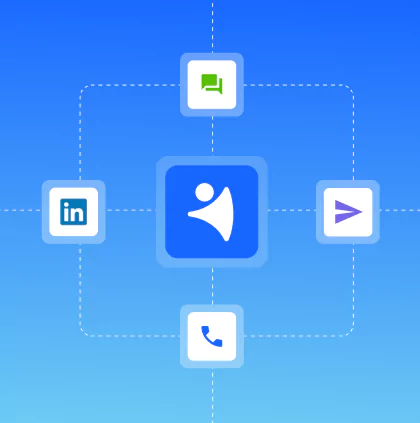Regardless of whether you’re a CRM vendor or CRM user, you need to keep up with all the latest CRM trends to keep your business afloat. It will either help you sell your solution to more customers or pick the solution to sell to more customers and make sure they stay with you for longer.
We’ve already talked about the top ten most prominent emerging CRM trends of the year 2022. But, granted the importance thereof, we thought we’d see if CRM practitioners agree with our predictions.
So, we reached out to a bunch of seasoned CRM analysts, experts and other professionals, to ask for their opinion of what’s going to happen to the CRM software industry, the adoption and role of CRM, as well as the future of CRM as a strategy.
We asked five CRM thought leaders a single question: What are your key CRM predictions for 2022? Which CRM functionality do you think will be big in the upcoming year, and which problems will it help business people to solve?
Some of the answers took an unexpected turn. So, strap in, and let’s get into it!

Andrei Petrik
CEO @NetHunt CRMAndrei Petrik is the CEO and Co-Founder at NetHunt CRM, a sales automation tool inside Gmail. Having been in the industry for more than 12 years, Andrei knows a thing or two about customer relations and business processes. Prior to developing his own product, Andrei worked closely with corporations on helping them implement enterprise-level CRM systems. When Andrei’s not churning out code, he's out on the water catching some fish!
— Modern CRM software is no longer just a tool for contact management — it's evolved into a multifunctional solution used by business people from all departments. What are your key CRM predictions for 2022? Which CRM functionality do you think will be big in the upcoming year, and which problems will it help business people to solve?
Data generation is now easy, thanks to tools like web forms, lead generation integrations, and lead enrichment applications. We did it.
Our obstacle as a CRM provider now lies in helping customers manage all that customer data. Where we could once look at the few data points in our database and draw a conclusion, the sheer volume of data now makes that impossible. That’s where CRM automation comes in.
Automation is a wonderful addition to CRM’s armoury, but it could be better. Not just for the sake of it, but to match the need that has arisen out of the advancement of data generation capabilities. I expect to see even more possibilities to automate different business processes. More triggers, actions, and helpers. It’s the next logical step.
The next logical step after automation is AI, right? While yeah, I do agree that AI should play a role in our CRM activities going forward; I also know that the technology isn’t there. People like to talk about AI because it sounds cool. The truth is, CRM automation capabilities now are nowhere near AI.
One day, AI will be able to make predictions, conclusions, and suggestions about our business. Right now, it's a superficial topic for the CRM industry. When we’re ready to talk seriously about AI in CRM, I'll be there with NetHunt CRM.
So let’s focus on what we can do. We want to bring synergy between all the different arms of a business. There are marketers working in email marketing tools, support teams working out of Intercom and chat applications, and only salespeople using CRM. They’re all working with the same customers on the same journeys, so why shouldn’t their stack be the same?
I predict that we’ll see CRM move horizontally. It’ll capture all your business departments and processes, automating what needs automating. It’ll become less about simple data storage and more about laying down a frictionless customer and employee experience. If you’re on Slack, we’ll meet you there. If you generate leads on LinkedIn, we’ll give you a slice of CRM data on every profile you visit.
CRM for everybody; everybody working together towards the same goals.

Thomas Wieberneit
Thomas is an internationally sought after analyst and consultant with more than 25 years of proven track record of leadership experience in the CRM and CX industry. Being an experienced practitioner with a unique combination of development, quality management and consulting experience, he effectively translates business needs into technology solutions, bringing strong value to software vendors and their customers.
— Modern CRM software is no longer just a tool for contact management — it's evolved into a multifunctional solution used by business people from all departments. What are your key CRM predictions for 2022? Which CRM functionality do you think will be big in the upcoming year, and which problems will it help business people to solve?
CRM software has not been only about contact management for more than 25 years now. It is also more than software that helps the sales organisation. Yet, many users are still unhappy with the implemented solution, and there are reports that they find more cost than benefit in a CRM deployment.
This is because many systems are still not implemented with the end-user in mind. In 2022, however, things will change thanks to improved technology, machine learning and conversational AI. These two, likely along with no code, will ease the way going forward.
The objective that more and more vendors will have in the upcoming year is to build software that makes it easier for the users to achieve their goals.
Conversational AI and conversational user interfaces are key for this. Conversational AI will make the interaction with the system more natural for users. While this will not yet become mainstream, we will see more and more applications of conversational interaction with CRM systems, either via text in Slack or MS Teams or via voice, e.g. via Twilio.
The same can be said about machine learning assisted scenarios. Today, we can see simple scenarios like opportunity scoring. But in 2022, there will be more and more scenarios that help users identify the next best actions in an increasing number of situations. This will be all about making it easier to achieve results, not to make people obsolete (so far).
No code will become more widely available with all its advantages and disadvantages. It will help in automating cumbersome processes. The flip side is that organizations need to make sure that they do not rediscover the times of Lotus Notes when huge databases of applications got created, producing a lot of data dirt.

Marshall Lager
Marshall Lager is an independent analyst covering CRM and related industries. Together with his colleagues Ralf Korb and Thomas Wieberneit, he is one of the CRM Evangelists providing advice and analysis to vendors and users alike. He is based in Chicago, Illinois, USA.
— Modern CRM software is no longer just a tool for contact management — it's evolved into a multifunctional solution used by business people from all departments. What are your key CRM predictions for 2022? Which CRM functionality do you think will be big in the upcoming year, and which problems will it help business people to solve?
CRM has become a catch-all term for every system of record or engagement for all the customer-facing work a business does. That makes it easy for industry watchers like me to make predictions because we’ve got so much to choose from.
First, I think we have reached Peak CX, meaning that customer experience is not going to be as impactful a buzzword as it has been the past couple of years. However, CX itself is going to remain critically important, and probably continue to grow in terms of industry footprint, because even the laggards have gotten the message that this is important stuff. There’s also a nonprofit group, the European Customer Experience Organization (ecxo.org) that will be working on education, communication and industry standards. It’s poised to expand in 2022.
My second prediction grows out of the first, specifically the mention of ECXO. CX isn’t the same everywhere, and successful techniques in Europe might not work as well in Latin America, and might fail outright in North America. My friend and colleague Jesús Hoyos of Solvis Consulting has been saying this for years, and I think we’re finally taking notice. Localization of CRM efforts, not just changing the language and currency, is going to become very important.
Third, artificial intelligence is developing into a versatile toolset for assisting and supporting employees at all roles and levels of business. The key terms here are assisting and supporting; while AI does have the ability to automate or offload some tasks, it really shines when used to back up a contact center rep or salesperson with real-time information, prompts, and suggestions—not doing the job for them, but enabling them to do more in the moment when it matters most. We will see increased emphasis on this aspect of AI, and less fear-mongering about robots taking our jobs.

Jordie van Rijn
Independent email marketing and eCRM consultant @EmailMonday and founder of EmailVendorSelection.— Modern CRM software is no longer just a tool for contact management — it's evolved into a multifunctional solution used by business people from all departments. What are your key CRM predictions for 2022? Which CRM functionality do you think will be big in the upcoming year, and which problems will it help business people to solve?
Gone are the days that sales reps were the first, trusted place to go for advice. The information balance has shifted to the customer.
Leads like to self-serve their knowledge gap. In fact, you’ve probably done it yourself, too. When you want to buy something, you start by checking what you can find yourself. Google it, watch a video, read an article, check out reviews. But it doesn’t only happen at top of the funnel. Such self-service is intrinsic to leads at every stage of the buyer journey.
Offering knowledge gap information via blogs, self-service portals, evergreen webinars, FAQs, forums is the way for businesses to take the matters into their own hands. In 2022, businesses need to keep tabs on their leads’ customer journey (that’s where CRM software comes in handy) and offer relevant, timely content. They should focus on creating demand for their product. The best way to do this is to inform potential customers about the needs they didn’t know they had. Just stay reasonable - every bit of information you offer must be paired with a clear explanation of what’s in it for your leads. Make sure to do it in an entertaining way (aka, stop being boring!)
I see that companies will treat data collection more intentionally as in 2022, data richness is business richness. Hence, filling the lead’s or customer’s profile becomes a primary marketing goal. The adoption of tease marketing and progressive profiling will take a more central place.
So what does this mean for CRM tools? In 2022, we can expect CRM to turn into an interface for your internal organization to connect smart technology like AI-powered chatbots and sites that dynamically change to fill profiles. Once customers interact with your business (in any way - there are CRMs that track every page visited on the website or webinar, down to the exact minutes the person was live on it), the CRM will automatically complete their profile in the system. Based on this info, you can offer them super-targeted additional content or product pitches.

Kalo Yankulov
Co-founder and CMO @EnchargeKalo is co-founder and CMO at Encharge. Kalo helps entrepreneurs and marketers grow their businesses with no-nonsense marketing automation and effective emails. He is especially focused on behavior-based marketing automation and other advanced email strategies.
— Modern CRM software is no longer just a tool for contact management — it's evolved into a multifunctional solution used by business people from all departments. What are your key CRM predictions for 2022? Which CRM functionality do you think will be big in the upcoming year, and which problems will it help business people to solve?
In 2022, teams will try to bridge the gap between sales and marketing even further. We are going to see a better inter-departmental alignment — from sales to the marketing team and everything in between, and CRM tools will play a major role in this.
CRMs will continue to serve as a single source of truth as they store all the critical contact information required by teams to make educated decisions and deliver personalized campaigns across the whole journey.
In 2022, we are going to see more CRM integrations — CRM platforms building integrations with external marketing and sales tools, and vice versa. That way data silos will be destroyed and teams will be able to work with up-to-date relevant data. Without that data sales and marketing teams won’t be able to be relevant or timely and will lose to other businesses that leverage the right data.
The type of integrations we are going to see are deep, native integrations that work seamlessly with platforms. The days of generic integrations are over — we are going to see tools develop in-depth two-way syncing and other features that allow you to use your CRM with other platforms.
Now that you’re armed with both theoretical and practical knowledge of the CRM trends in 2022, you have all it takes to smash it and boost your business. Don’t blow your chance!




















 product experts — let's find the best setup for your team
product experts — let's find the best setup for your team